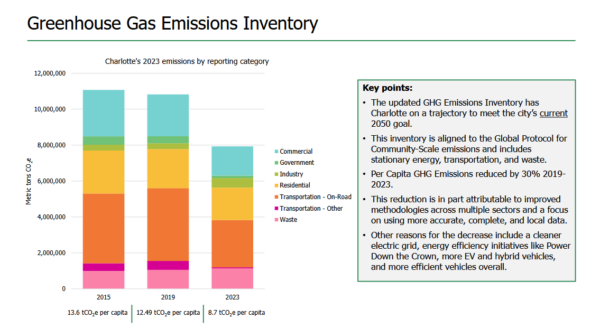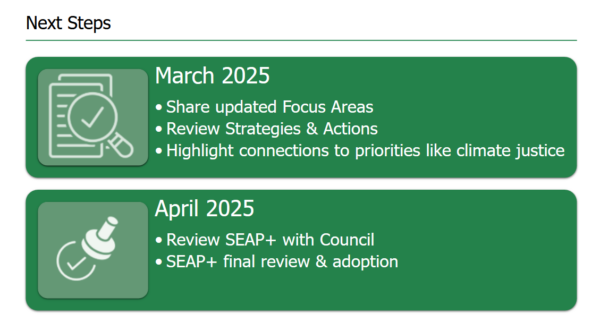4 ways Charlotte’s Strategic Energy Action Plan could soon change
A lot has happened in just four months since we first informed you that the City of Charlotte had begun updating its Strategic Energy Action Plan, or SEAP!
In our previous blog post, we shared the reasons for the update. As a member of the SEAP Technical Advisory Committee, Sustain Charlotte’s staff have helped shape the update by reviewing progress and giving feedback.
First, some exciting news: Charlotte’s per capita greenhouse gas emissions decreased by 30% from 2019 to 2023. Some of the decrease is due to better inventory methodologies and data sources, but there’s also a real impact from a cleaner energy grid, energy efficiency initiatives, and more efficient vehicles including EVs and hybrids.

City of Charlotte
Here are the major areas where the draft SEAP update, which will be known as “SEAP+”, differs from the currently adopted plan:
Charlotte will reduce community-wide greenhouse gas emissions 72% (to 3.56 mt CO2e per capita) by 2035 and reach net-zero by 2050. Two reasons we love this goal: First, it’s more ambitious than the previous goal of becoming a low-carbon city by 2050. Second, it now includes an interim science-based goal for 2035 to ensure we stay on track to reach the 2050 goal.
A climate goal is considered “science-based” if it meets three criteria: Aligned with the global goal to limit global warming to 1.5 degrees C, Equitable, and Complete (includes all key emissions sources).
600 MW of distributed renewable energy will be installed in Charlotte by 2035.* (*could vary from 600 to 1,000MW). Charlotte’s rooftop solar installations have dramatically risen in the last 5 years, with 70% of all current rooftop capacity having been installed since 2019.
Why does this goal matter? Reducing our reliance on fossil fuels that accelerate climate change requires changes in how we produce and consume energy. As we shift from natural gas to electricity to heat buildings, and as more people adopt electric vehicles, we need an electric grid that is increasingly based on renewable energy including solar.
The following two revised goals relate to how the city will transition to the use of renewable energy to power city buildings and vehicles over the coming decades. The currently adopted goal is for city buildings and vehicle fleets to be powered by zero-carbon sources by 2030. Here’s what could change in the SEAP+:
Buildings goal: The city will source 100% of its electricity use in municipal buildings from zero carbon sources by 2030 and reach net zero emissions in municipal buildings by 2050. Most of the city’s buildings are powered by either electricity or natural gas. The city’s Sustainable Facilities Policy means that only electric power is being installed in new buildings. However, converting some of the existing buildings that use natural gas to instead be powered by electricity would be either very costly to taxpayers and/or unfeasible. The city will focus on sourcing its electricity from zero-carbon sources and reaching the 2050 goal of net zero emissions in municipal buildings.
Vehicle goal: The city will reach net zero emissions in its light-duty fleet by 2035 and in its entire fleet by 2050. The rate of technological progress for light-duty vehicles (think: passenger sedans, SUVs, and pickup trucks) has been much faster than for heavy-duty vehicles like solid waste trucks, firetrucks, and other large equipment. The good news is the city is making great progress on transitioning the light-duty vehicle fleet to renewable energy.
But the availability for larger vehicles isn’t quite where it needs to be to hit the zero emissions goal for the entire vehicle fleet within the next decade, which led to the goal change. For example, CATS is poised to soon have the largest fleet of electric buses in the southeastern U.S. However, there isn’t yet a reliable electric bus model that can travel the longer distances that an express bus route requires. Similarly, solid waste vehicles must operate for many hours a day so that the crews can complete their routes, though there isn’t yet a cost-effective zero-emissions truck that can provide the needed all-day coverage.
Staying hungry to innovate
The proposed changes to the current goals reflect the city’s desire to set ambitious, attainable, and aspirational goals that are well-grounded in science. The city is building the first all-electric fire station in Steele Creek and testing a variety of renewable energy-powered vehicles. Their major investment in a solar farm will help reduce reliance on fossil fuels. We look forward to Charlotte staying on the leading edge of innovation as we adopt climate-friendly policies and investments!
What’s next?

City of Charlotte
Share your input at the March 6 SEAP public engagement event!
The City of Charlotte is dedicated to building a healthier, more sustainable future for all. You’re invited play a crucial role in this journey by reviewing the draft goals, actions, and strategies at an upcoming Drop-in style event, for the updated Sustainable Energy Action Plan (SEAP+).
Event Details
Date: Thursday, March 6, 2025
Time: 5:30 PM - 8:00 PM (Drop-in)
Location: Belmont Regional Center
700 Parkwood Ave. Charlotte, NC 28205
Refreshments served
Families welcome
